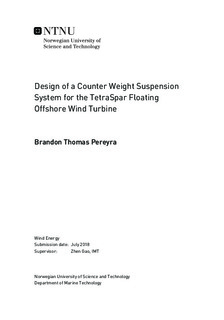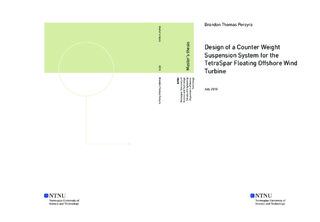| dc.description.abstract | New floating wind turbine designs are needed to reduce production costs and to increase mass production feasibility. The TetraSpar floating wind turbine achieves these goals by being constructed using components highly suitable for standardization and industrialization. The design makes use of a suspended submerged counter weight to obtain a low center of gravity for the floating system, while also allowing a low draft during transport and installation. An analytic analysis of the counter weight suspension system is presented that investigates the behavior of the system. The main concern of the novel system is its motion relative to the upper floating platform which it is connected to. It is demonstrated that the suspended system's motion is described by the axial elongation of the suspension lines when positive tension is maintained in all suspension lines. An analytic solution for the equivalent stiffness of the suspension system is given. This suspension system stiffness introduces additional natural frequencies into the system, and the effects of these frequencies are demonstrated.
This novel concept requires a multibody modeling approach to perform a dynamic loads and response analysis, as the stiffness between the floating platform and the counter weight is provided by chains. Additional design criteria are required for the counter weight system dependent on a combination of chain capacity and maintaining positive tension in all of the suspension lines. To satisfy these design criteria a global hydrodynamic load and response analysis of the floating system is performed. In this concept, the counter weight depth contributes significantly to the dynamic properties of the system and therefore a parametric study is conducted. The global response parameters of the rigid-body motion, natural frequencies, nacelle accelerations, counter weight chain tensions, and maximum platform-pitch angles are compared. Following the parametric study, an ultimate limit state analysis is conducted on the original and alternative designs. Design recommendations are made for the counter weight depth and configuration of the suspension system layout. | |

